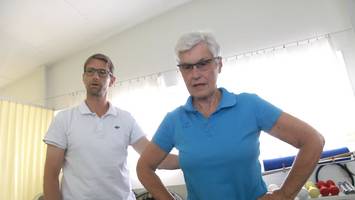Leg length inequality, pelvic obliquity
Definition
Causes
- sometimes results from a hip TEP operation (artificial hip joint)
- congenital: club foot, congenital hip dislocation, coxa vara, for example
- infection-related: Osteomyelitis, septic coxitis
- paralysis-related: cerebral palsy, poliomyelitis
- Traumatic: the result of bone fractures or injuries to the epiphyseal plate
- tumour-related:
- miscellaneous: leg malalignment (valgus malalignment, varus malalignment, Legg-Calve-Perthes disease)
- arthrotic hip joint
- Hip contracture (increased inclination, adduction or abduction)
- Contractures in the knee
- Drop foot
Long-term consequences
- Tiptoeing: Walking on the toes of the short leg reduces the influence of the difference in length. Many women do this even in pumps.
- Raised shoes
Conventional therapy
- orthopaedic shoe alteration (raised heels with sole adjustment and insoles)
- custom-made orthopaedic shoes or custom-made shoes with inner shoes or foot bedding orthesis
- Elevated shoes or orthopaedic leg orthesis, or in extreme cases and on physician recommendation, surgery
The kybun principle of operation – being proactive
The positive effect of kybun shoes on your posture combined with the natural rollover motion relieves the tension in your muscles (such as back tension), significantly improving your wellbeing.
The kybun springy, elastic sole can compensate for differences in leg lengths to a certain degree (up to approx. 1 cm). There are a number of different measures you can take to adapt kybun shoes to your personal needs if the difference in your leg lengths is greater. please click here for more informationInitial reactions
kybun exercises
- If possible, seek a solution before interval walking: Differences of up to 1 cm can be compensated for by the soft, elastic material; greater differences require consultation with kybun.
- Always look straight ahead (improves posture)
- During slow exercises, imagine a thread attached to your head, pulling it upwards
- Upper body straightening - During fast exercises: Clasp your hands in front of your stomach
- more energetic rotation of hips, back and shoulders
- During fast exercises: Clasp your hands in front of your stomach
- more energetic rotation of hips, back and shoulders so that the pelvic posture is changed as consciously as possible - conduct both exercises with a focus on the changeover
- long-term: Musculature must adapt to the new posture - Always look straight ahead (improves posture)
- During slow exercises, imagine a thread attached to your head, pulling it upwards
- Upper body straightening
Application tips
- Do not make your steps too long
- Everyday/leisure: Walk with the kybun shoe or use the kybun mat as much as possible. Take note of fatigue > perform the kybun exercises regularly and take a short break if needed.
- Walk upright
- Job: Sit as little as possible. Alternate sitting and standing in the beginning, and take along replacement shoes to change into
- Initial reactions such as back pain or an increase in your existing back pain when using the kybun shoe or the kybun mat may be due to various reasons (e.g. tense muscles, movements that are unfamiliar for the back). The body should have progressively fewer initial reactions if the dosage is adjusted correctly (increase duration of wear at your discretion).
- If you do not feel comfortable in the kybun shoe despite following the ‘Application tips’, we advise you to consult a local kybun dealer.
Opinions/customer testimonials
I have scoliosis since childhood, probably as a result of 1 cm one leg short, I'm still living with pain (in the back, below the right shoulder blade, then began to manifest pain in the hip). I did not know nothing about Swiss footwear brand kybun. Fortuitously, I met a man that works with the company kybun. I studied the technology and started with trust to wear kybun shoes. After one year and two months since I got the kybun shoe, I can 100% certainty that biomechanoterapi works. No pain under the shoulder blade! I have no pain in the hip, strengthened stability in the legs. I thank God that he took care of my health and gave me new friends.










